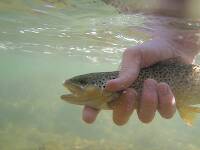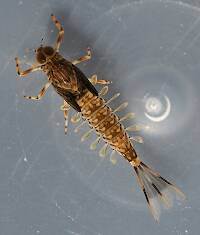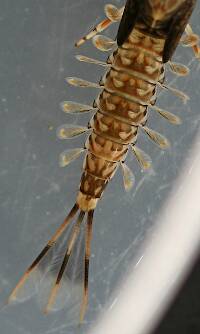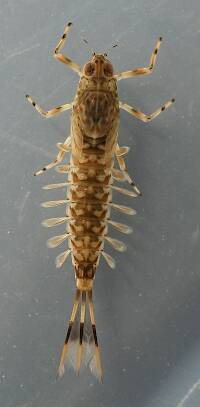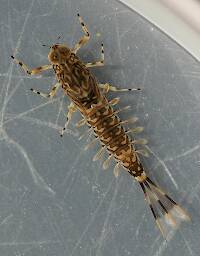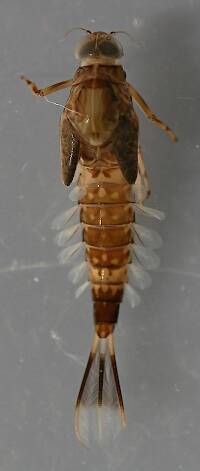
Hex Mayflies
Hexagenia limbata
The famous nocturnal Hex hatch of the Midwest (and a few other lucky locations) stirs to the surface mythically large brown trout that only touch streamers for the rest of the year.
Featured on the forum

It's only barely visible in one of my pictures, but I confirmed under the microscope that this one has a prosternal horn and the antennae are mid-way between the eyes and front of the head capsule.
I'm calling this one Pycnopsyche, but it's a bit perplexing. It seems to key definitively to at least Couplet 8 of the Key to Genera of Limnephilidae Larvae. That narrows it down to three genera, and the case seems wrong for the other two. The case looks right for Pycnopsyche, and it fits one of the key characteristics: "Abdominal sternum II without chloride epithelium and abdominal segment IX with only single seta on each side of dorsal sclerite." However, the characteristic "metanotal sa1 sclerites not fused, although often contiguous" does not seem to fit well. Those sclerites sure look fused to me, although I can make out a thin groove in the touching halves in the anterior half under the microscope. Perhaps this is a regional variation.
The only species of Pycnopsyche documented in Washington state is Pycnopsyche guttifera, and the colors and markings around the head of this specimen seem to match very well a specimen of that species from Massachusetts on Bugguide. So I am placing it in that species for now.
Whatever species this is, I photographed another specimen of seemingly the same species from the same spot a couple months later.
I'm calling this one Pycnopsyche, but it's a bit perplexing. It seems to key definitively to at least Couplet 8 of the Key to Genera of Limnephilidae Larvae. That narrows it down to three genera, and the case seems wrong for the other two. The case looks right for Pycnopsyche, and it fits one of the key characteristics: "Abdominal sternum II without chloride epithelium and abdominal segment IX with only single seta on each side of dorsal sclerite." However, the characteristic "metanotal sa1 sclerites not fused, although often contiguous" does not seem to fit well. Those sclerites sure look fused to me, although I can make out a thin groove in the touching halves in the anterior half under the microscope. Perhaps this is a regional variation.
The only species of Pycnopsyche documented in Washington state is Pycnopsyche guttifera, and the colors and markings around the head of this specimen seem to match very well a specimen of that species from Massachusetts on Bugguide. So I am placing it in that species for now.
Whatever species this is, I photographed another specimen of seemingly the same species from the same spot a couple months later.

Troutnut is a project started in 2003 by salmonid ecologist Jason "Troutnut" Neuswanger to help anglers and
fly tyers unabashedly embrace the entomological side of the sport. Learn more about Troutnut or
support the project for an enhanced experience here.
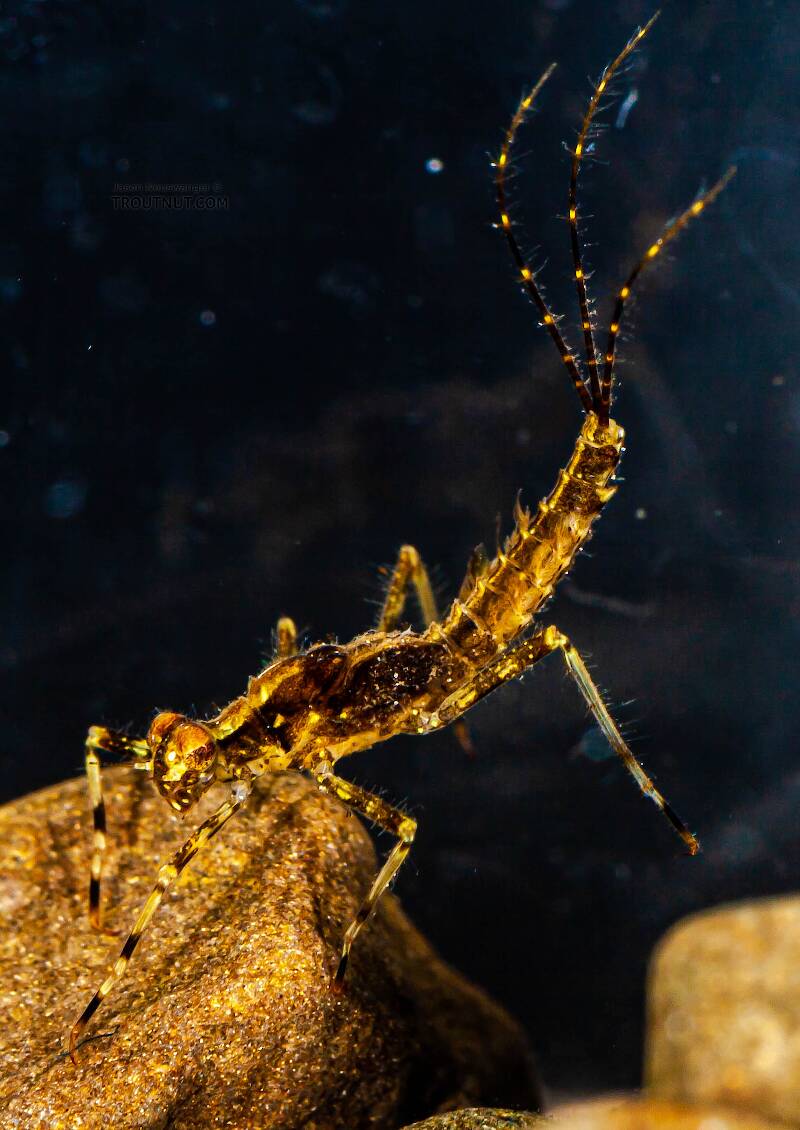
This is surely the most distinctive-looking species in Ephemerellidae. I like the rugged, spindly look. If mayflies made movies, Penelomax septentrionalis would probably play the supervillain.
Maybe I should take a break and get something to eat.
Maybe I should take a break and get something to eat.
Earlfishman
Posts: 17
Posts: 17
Earlfishman on May 19, 2007May 19th, 2007, 8:07 am EDT
Jason,
The underwater photos are unreal. What sort of lens are you using on that camera? It is just now occuring to me to ask how many of your pictures on this site are taken through a scope and how many are taken with just a camera?
Earl
The underwater photos are unreal. What sort of lens are you using on that camera? It is just now occuring to me to ask how many of your pictures on this site are taken through a scope and how many are taken with just a camera?
Earl
GONZO on May 19, 2007May 19th, 2007, 8:56 am EDT
Jason, these are the first photos of septentrionalis I've seen--very cool! I've been meaning to discuss this species with Greg Hoover, but I probably won't have a chance to do that until mid-June. I'll be sure to share whatever I learn.
Troutnut on May 19, 2007May 19th, 2007, 3:14 pm EDT
Almost all my photos are taken without a microscope, but I do have a very specialized macro photography setup. The "underwater" photos in specimens like this one are actually not underwater, but staged in a tiny aquarium I created to take more natural-looking pictures than my usual white-background ones.
Jason Neuswanger, Ph.D.
Troutnut and salmonid ecologist
Troutnut and salmonid ecologist
Quick Reply
Related Discussions
Topic
Replies
Last Reply
4
Apr 21, 2007
by PeterO
by PeterO
8
Feb 12, 2009
by Troutnut
by Troutnut



